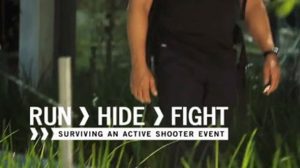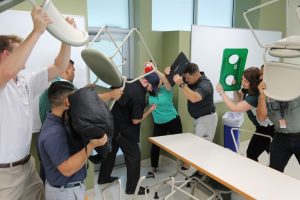Posted December 18, 2017
By ANDRES ARENAS GRAYEB
What do you know to do if there is an active shooter on campus?
Dominic Intrieri, a marketing major at the University of Miami, said he did not know.
“Nothing,” he stated when asked. “Who does know? Do you even think he knows?”
By “he,” Intrieri was referring to Prof. Michael De, who was just arriving to begin the day’s philosophy class.
“I wasn’t told anything about what to do if there is a shooter,” De admitted. “But I do feel safe.”
At that, Intrieri laughed and said, “See!? Well now I feel unsafe!”
Whether or not Intrieri was joking when he said this, no one could blame him if he were telling the truth. Shooting incidents are becoming much more common in the United States and they’re not becoming any less deadly.
One of the most deadly occurred on Oct. 1 at a Las Vegas music concert, where more than 50 people were killed and more than 500 were injured by gunman Stephen Paddock. He was found dead by police in the hotel room from which he fired, along with 23 weapons according to reports.
Mass shootings of this scale are rare, but smaller ones occur all around the country at an alarming rate. The Gun Violence Archive website has listings of such shootings that, although not great in scale, are often separated by no more than a day or two from each other.

The opening shot for a video made by the University of the District of Columbia, showcasing the Run, Hide, Fight response (Photo courtesy of University of Miami Emergency Management Director Matthew Shpiner).
Naturally, this growing threat is an ongoing concern for not just individuals, but institutions as well.
The University of Miami is no exception: its Office of Emergency Management has implemented the “Run, Hide, Fight” awareness campaign run by the U.S. Department of Homeland Security.
According to UM Emergency Management Director Matthew Shpiner, the purpose of the campaign is to provide an easy starting point for individuals to learn how to handle an active shooter.
There is more to preparing for a shooting than what the slogan advocates, however.
“Run, Hide, Fight are the first three words, but they are not the only three words,” Shpiner affirms. “We want to empower people with information, but we don’t want people to take a robotic response to this. A lot of this has to do with
analyzing the situation, and making the best protective actions and decisions you can based on the information that’s available.”
Another way the UM Emergency Management office empowers people with information is with its Active Shooter Response Training program, which takes the form of 90-minute classes available to any group of 15 or more people.
The classes are offered year-round and are designed to arm its students with general emergency preparedness behaviors while also exposing them to simulations of the real deal.
John Anthony Gulla, a UM Emergency Management coordinator and instructor of these classes, stresses that one of the most important parts of being prepared for an emergency is having a plan.
“The training is intended to communicate the vital notion that having a plan in place and thinking about emergency preparedness options ahead of time will dramatically increase survivability of such an incident,” Gulla said. “The course instructs those involved in learning facts related to previous active shooter incidents (and why they matter), what their best options are for immediate response and why they should commit to being more mentally and physically prepared ahead of time.”

An Active Shooter Response Training class captured in the middle of an emergency simulation (Photo courtesy of John Anthony Gulla).
The course isn’t solely focused on preparing for the emergency itself, however. It also emphasizes prevention: a day to day approach at making the campus safer.
“In addition to learning about the mindset of a perpetrator … we also discuss how some people may be in a good position to note long-term changes in behavior or note potential threats / preparations made by a perpetrator prior to committing the violence,” Gulla continued. “It is known through prior incidents that these markers exist and that, many times, there were people who were in a position to notice odd things that gave them a sense of foreboding or a “bad feeling,” but still failed to report it to the proper officials, instead talking themselves out of acting on their instinctive perceptions.”
This hesitation to act or speak without evidence is the target of another awareness campaign of the U.S. Department of Homeland Security: If you See Something, Say Something. University of Miami Police Department Detective Alberto Alonso talks about a few misconceptions the campaign tries to combat.
“Nothing is too small,” Alonso stated. “If you have a suspicion about something you think is not right, say something. If you call in on something and it turns out to be nothing, the police are not going to get mad or think you are dumb for calling. We take everything serious.”
“We want people to be involved,” Shpiner advised. “We can mitigate these threats through enhanced awareness in our community. We want them to report what they are seeing: we can almost eradicate crime on this campus if we got everyone involved in the process, and have another 15,000 sets of eyes and ears helping us to monitor those things that appear out of the ordinary.”
There are resources to help the university community prepare for a shooter emergency. The university staff and police have your back. You know to be flexible with your decision making in the case of an emergency, but to say something if you see something in order to prevent emergencies from happening in the first place.
Is that it? Almost, but not quite. There is still more you can do to prepare for an emergency. They can be small foresights, such as packing a basic emergency preparedness kit, but the primary way to be ready is to be informed.
“By being aware of the information provided during the training and being more aware of our surroundings and the actions of persons around us, we contribute immensely to the safety of our campus as a whole,” Gulla concluded. “Not only for active shooter incidents, but for many other types of potential threats to safety, whether they are man-made, natural or technological in nature.”
